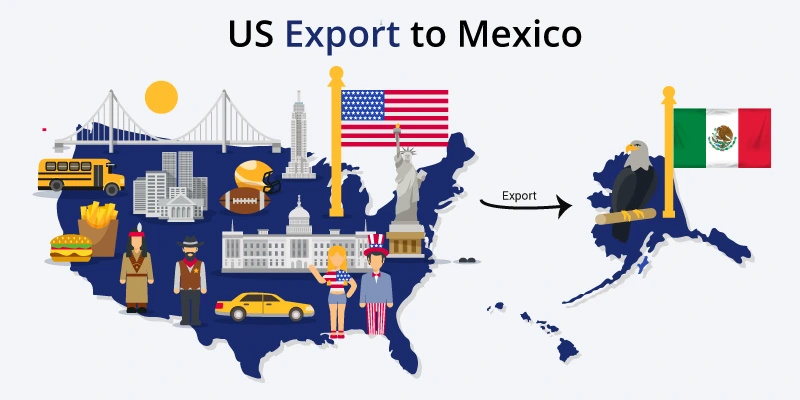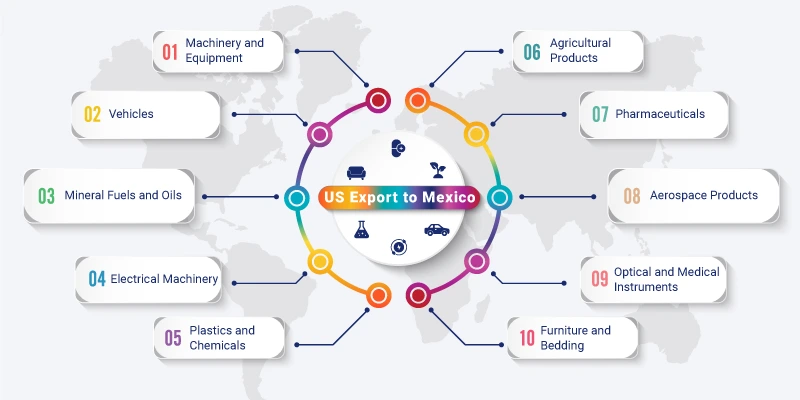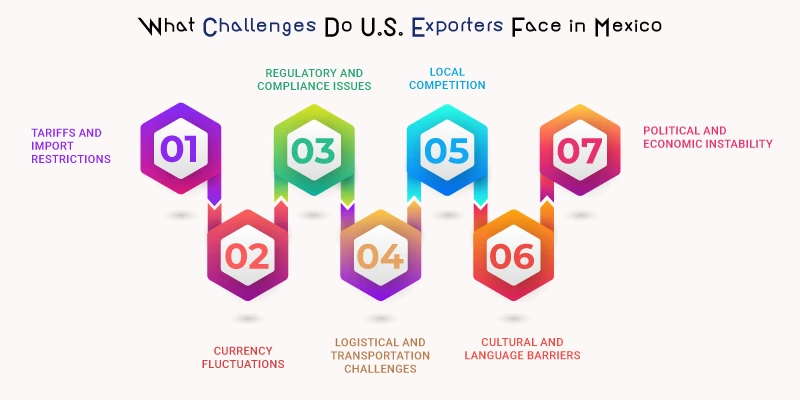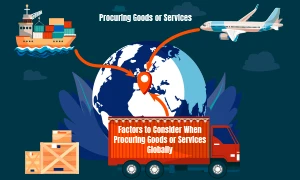
The United States is one of Mexico's largest trading partners, with a diverse range of exports fueling the strong economic ties between the two countries. In 2021, U.S. exports to Mexico reached $276.5 billion, marking a 30.7% increase from the previous year. This trade relationship continues to thrive, with key exports like refined petroleum, motor vehicles, and integrated circuits leading the way. For example, in November 2024, top U.S. exports to Mexico included Refined Petroleum ($3.1 billion), Motor Vehicles, Parts, and Accessories ($1.6 billion), and Integrated Circuits ($1.06 billion).
Let’s take a closer look at what the U.S. exports to Mexico and how these products impact both economies.
Why U.S. Exports to Mexico are Crucial for the American Economy
The trade relationship between the United States and Mexico is one of the most important in the world, driving economic growth and collaboration. Here’s why exports to Mexico are vital for the U.S. economy:
- Billions of dollars in goods and services are exchanged annually, contributing significantly to both economies.
- U.S. exports create millions of jobs across sectors like manufacturing, agriculture, and technology, boosting economic stability.
- With over 120 million people, Mexico offers a vast consumer base, helping U.S. businesses expand their reach and revenue.
- Proximity to Mexico allows for efficient, cost-effective trade, with many U.S. companies benefiting from lower labor costs and favorable agreements like the USMCA. Must see: Low Cost Country Sourcing
- Many U.S. industries rely on parts and components made in Mexico, improving manufacturing efficiency and reducing production costs, especially in agriculture.
As trade grows, leveraging this strategic partnership will remain crucial for fostering continued prosperity and innovation in North America.
What does the US Export to Mexico?
The United States is one of Mexico's largest trading partners. It exports a wide range of products to Mexico. These goods play a key role in the relationship between the two countries.

1. Machinery and Equipment
The US exports machinery and equipment to Mexico. This includes computers, engines, and electrical machinery. These products help support industries in Mexico, especially in manufacturing and construction.
2. Vehicles
Cars and trucks are major exports from the US to Mexico. Many American car brands have factories in Mexico. As a result, the US exports both finished vehicles and parts for assembly in Mexico.
3. Mineral Fuels and Oils
Mineral fuels and oils are another significant export. The US sells gasoline, petroleum, and other oil-based products to Mexico. These resources are vital for Mexico's energy needs.
4. Electrical Machinery
Electrical machinery, including circuit boards and telecommunications equipment, are also key exports. These products are essential for Mexico's technology sector and communication networks.
5. Plastics and Chemicals
The US exports a wide range of chemicals and plastics. These materials are used in everything from manufacturing to packaging. Mexico uses them for both domestic production and further export.
6. Agricultural Products
The US exports a lot of agricultural goods to Mexico. This includes corn, soybeans, wheat, and meat products. American farms supply a large portion of Mexico’s food needs.
7. Pharmaceuticals
Pharmaceuticals and medical supplies are important exports. The US sells both prescription drugs and medical devices to Mexico. These products are crucial for healthcare in the country.
8. Aerospace Products
Aerospace products, like airplanes and parts, are a growing export category. The US supplies these products to Mexico's aerospace industry. Mexico assembles and exports many of these products globally.
9. Optical and Medical Instruments
Optical and medical instruments are also exported to Mexico. These include items like medical diagnostic tools and eyeglasses. These exports support Mexico’s healthcare sector.
10. Furniture and Bedding
The US exports furniture and bedding to Mexico. These goods are widely used in homes and businesses. The trade in furniture continues to grow as demand rises.
Current State of Mexico's Trade Relationships and Agreements
Mexico has a strong presence in global trade, supported by a variety of strategic trade agreements that drive economic growth and international collaboration. These partnerships span continents and aim to boost exports, attract foreign investment, and promote regional integration.
United States-Mexico-Canada Agreement (USMCA)
The USMCA, previously NAFTA, is Mexico's most important trade pact. It enhances trade and investment between Mexico, the U.S., and Canada, particularly in automotive, agriculture, and manufacturing sectors.
European Union-Mexico Free Trade Agreement (EU-Mexico FTA)
The EU-Mexico FTA provides preferential access to European markets, supporting Mexican exports in industries like automotive, electronics, and agri-foods.
Comprehensive and Progressive Agreement for Trans-Pacific Partnership (CPTPP)
As a member of the CPTPP, Mexico has expanded trade ties with countries across the Asia-Pacific, including Japan, Australia, and Vietnam, boosting its competitiveness in electronics, machinery, and agri-food sectors.
Pacific Alliance
Mexico is part of the Pacific Alliance, a trade bloc with Colombia, Chile, and Peru, focused on economic integration in Latin America, encouraging free trade, innovation, and investment.
Other Free Trade Agreements (FTAs)
Mexico has FTAs with several countries, including Israel, Japan, and nations across Central and South America. These agreements diversify Mexico’s markets, reducing reliance on any single partner and expanding export opportunities.
With over 50 trade agreements, Mexico’s trade sector is diverse and full of potential. This diversity enhances its global market access and attracts foreign investment, driving continued economic growth.
Read More: What products to import from Mexico?
What Challenges Do U.S. Exporters Face in Mexico?
U.S.-Mexico trade relationship is strong, but U.S. exporters face several challenges when doing business in Mexico. These obstacles can affect efficiency, profitability, and long-term success.

1. Tariffs and Import Restrictions
Though the USMCA provides preferential trade terms, tariffs and import restrictions can still complicate the export process. U.S. exporters must navigate these regulations, which vary by product category.
2. Currency Fluctuations
The value of the Mexican peso can fluctuate, impacting the cost of U.S. exports. These fluctuations can make it difficult for U.S. exporters to predict pricing and profitability.
3. Regulatory and Compliance Issues
Mexico has complex regulations concerning labeling, packaging, and safety standards. U.S. exporters need to ensure compliance with these requirements to avoid delays, fines, or product rejection.
4. Logistical and Transportation Challenges
Mexico's transportation infrastructure, while improving, can still present challenges for timely delivery. Issues such as congestion at border crossings and limited shipping options can disrupt the flow of goods.
5. Local Competition
Mexican businesses are often strong competitors, particularly in sectors such as manufacturing and agriculture. U.S. exporters may face stiff competition from local companies, which may be able to offer lower prices or adapt more quickly to market changes.
6. Cultural and Language Barriers
Cultural differences and language barriers can impact communication and negotiations. Building trust and understanding local business practices is essential for successful export operations.
7. Political and Economic Instability
Political changes, economic fluctuations, or policy shifts can create uncertainty for U.S. exporters. Shifts in government priorities or economic conditions in Mexico may affect the trade landscape.
Despite these challenges, U.S. exporters continue to find success in Mexico by adapting to local conditions, leveraging trade agreements, and building strong relationships.
Future Outlook for US Exports to Mexico
The future of U.S. exports to Mexico to Mexico is currently uncertain due to recent developments in trade relations. On February 1, 2025, President Donald Trump announced the imposition of 25% tariffs on all Mexican exports to the United States, citing concerns over illegal immigration and the supply of fentanyl. In response, Mexico has indicated plans to retaliate with its own tariffs and non-tariff measures.
Economists predict that these tariffs could significantly disrupt trade between the U.S. and Mexico, potentially leading to a 6% decline in U.S. exports to Mexico and a 9% reduction if Mexico retaliates.
Specific sectors are expected to be more vulnerable:
- Automotive Industry: Accounts for 25% of Mexico's total exports. Without mitigation, exports could drop by 15-20%, potentially leading to a loss of $12-18 billion.
- Electronics & Machinery: Represents 16% of Mexico's exports. Without mitigation, exports could drop by 12-18%, potentially leading to a loss of $8-14 billion.
- Agriculture: Mexico is a top supplier of fresh fruits and vegetables to the U.S. Without mitigation, exports could drop by 10-15%, potentially leading to a loss of $2-3 billion.
- Textiles & Apparel: Without mitigation, exports could drop by 20-25%, potentially leading to a loss of $1-2 billion.
- Steel & Aluminum: Without mitigation, exports could drop by 15-20%, potentially leading to a loss of $3-5 billion.
In response to these developments, Mexican Economy Secretary Marcelo Ebrard is scheduled to meet with U.S. officials to discuss trade relations and seek clarification on the proposed tariffs.
Given the evolving nature of these trade policies, businesses engaged in the U.S.-Mexico trade should closely monitor official communications and consider strategic adjustments to manage the potential impacts of these tariffs.
U.S.-Mexico Trade: Sourcing Opportunities with SIXM
The evolving tariffs and trade policies may present challenges, but they also offer opportunities for strategic growth and innovation. By staying ahead of potential shifts, businesses can continue to thrive in a dynamic market.
At SIXM, we remain committed to offering insights and solutions that help our partners succeed in both times of change and stability. The future of U.S. exports to Mexico will undoubtedly be shaped by both cooperation and competition, but with the right strategies in place, success is within reach.
Sourcing from Mexico is now easier than ever with SIXM — your trusted partner in global supply chain management. As a leading sourcing company, we’ve streamlined the process to ensure you access high-quality goods at competitive prices, all while managing the complexities of cross-border trade with ease.

